Dell Latitude 15 5531 review
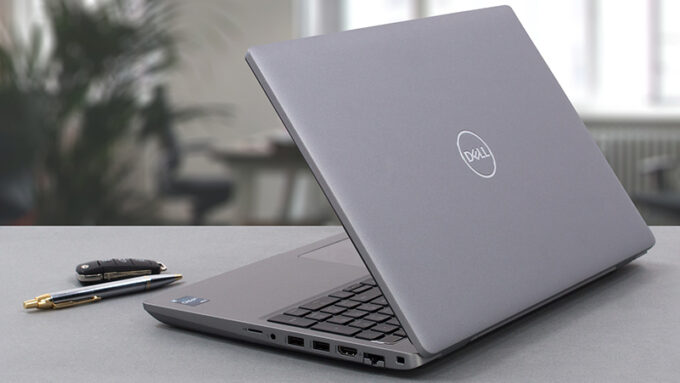 We have just taken a look at the low-voltage version of this laptop – the Latitude 15 5530. There, we praised it for its environment-conscious build and great feature set. Albeit being largely the same, the Latitude 15 5531 has some key differences from its twin brother. As is with Dell’s history of laptop names, the “1” at the end indicates more powerful hardware being used to run it.
We have just taken a look at the low-voltage version of this laptop – the Latitude 15 5530. There, we praised it for its environment-conscious build and great feature set. Albeit being largely the same, the Latitude 15 5531 has some key differences from its twin brother. As is with Dell’s history of laptop names, the “1” at the end indicates more powerful hardware being used to run it.
In this case, they swapped the 15W and 28W Alder Lake chips for some full-blown 45W processors of the same architecture. Needless to say, they are currently the Creme de la Creme of the mobile world. Thanks to Intel’s conversion to the big.LITTLE form factor, you get a ton of cores, and supposedly – great efficiency.
Ultimately, this should allow you to use the Latitude 15 5531 as a dedicated device for complex calculations, architecture, 3D design, and more. Of course, the fact that this is a Latitude, hence it has security enhancements, makes it even more suitable for the job.
You can check the prices and configurations in our Specs System: https://laptopmedia.com/series/dell-latitude-15-5531/
Contents
Specs Sheet
- HDD/SSD
- tot 2000GB SSD
- M.2 sleuf
- 2x 2280 M.2 NVMe slots with RAID support Zie foto
- RAM
- up to 64GB
- OS
- Windows 11 Pro, Windows 10 Pro, Windows 11 Home
- Batterij
- 64Wh, 4-cell
- Lichaamsmateriaal
- Plastic / Polycarbonate, Carbon
- Afmetingen
- 357.80 x 233.30 x 22.67 - 24.05 mm (14.09" x 9.19" x 0.89")
- Gewicht
- 1.79 kg (3.9 lbs)
- Poorten en connectiviteit
- 1x USB Type-A
- 3.2 Gen 1 (5 Gbps)
- 1x USB Type-A
- 3.2 Gen 1 (5 Gbps), Sleep and Charge
- 2x USB Type-C
- 4.0, Thunderbolt 4, Power Delivery (PD), DisplayPort
- HDMI
- 2.0
- Kaartlezer
- microSD (SD/SDHC/SDXC)
- Ethernet LAN
- 10, 100, 1000 Mbit/s
- Wi-Fi
- 802.11ax
- Bluetooth
- 5.2
- Audio-aansluiting
- 3.5mm Combo Jack
- Kenmerken
- Vingerafdruk lezer
- optional
- Web camera
- HD
- Verlicht toetsenbord
- optional
- Microfoon
- Dual Array Microphones
- Sprekers
- 2x 2W, Stereo Speakers
- Optische drive
- Slot voor veiligheidsslot
- Wedge Lock
Alle Dell Latitude 15 5531 configuraties
What’s in the box?
Interestingly, this laptop came with a completely unbranded black cardboard box. It’s like Dell has started selling cigarettes in western Europe. Nevertheless, it houses a 135W USB Type-C charger and some paperwork.
Design and construction
Like the Latitude 15 5530, the 5531 comes with a thick body measuring 22.67-24.05mm. However, it adds some 200 grams on top of the 1.59 kg starting weight of the former. Generally, it doesn’t feel too different, and it also has a quite durable body.
The grey matte finish is always a good thing if you like to see your device neat and clean. Unfortunately, the lid can’t be opened with a single hand. On the bright side, the bezels are thin, and once you open the lid, you can stretch it all the way down to 180-degrees.
Additionally, the matte display sports pretty thin bezels around it. Furthermore, the top one houses an HD (or Full HD) Web camera with a privacy shutter, and an optional IR face recognition scanner.
Since we’re talking about biometrics, it’s the perfect moment to mention the optional fingerprint reader, embedded in the power button. It is pretty fast and reliable. Moreover, the entire keyboard is comfortable for typing thanks to its decent key travel, clicky feedback, and large NumPad area.
On the other hand, the touchpad is a bit of a mixed bag. Its rough surface isn’t ideal if you like smooth gliding. However, we found it pretty responsive.
Now, if you turn the laptop upside down, you will be able to see the speaker cutouts, as well as the ventilation grill, placed directly beneath the fan. After the cool air enters the system, it is immediately turned into warm air and gets exhausted through a vent on the left side of the laptop.
Ports
On the left side, there are two Thunderbolt 4 connectors and an optional Smart Card reader. Then, on the right, you get a security lock slot, a LAN port, an HDMI 2.0 connector, two USB Type-A 3.2 (Gen. 1) ports, an audio jack, and a MicroSD card reader.
Disassembly, upgrade options, and maintenance
To get inside this notebook, you need to undo 9 Phillips-head screws. Then, pry the bottom panel with a plastic tool and remove it from the chassis.
Our unit comes with the smaller of two battery options. It has a capacity of 64Wh and lasts for more than 10 hours of Web browsing, or nearly 9 hours of video playback.
The upgrade options include two SODIMM slots for up to 64GB of GDDR5 memory. In addition, you get two M.2 PCIe x4 slots, which can work in RAID mode, as well as a 2.5-inch SATA drive bay.
Here, the cooling comprises two thick heat pipes, shared between the CPU and the GPU. Both the fan and the heat sink have quite a thick profile.
Display quality
“What year is it?” …is what we thought when we saw that we can order a configuration with an HD TN panel. Let’s pretend that we haven’t seen it, there are Full HD IPS and 4K IPS options. We bought one with a 1080p resolution and it has a model number BOE 2GMF6-NV15N4V (BOE0928). Its diagonal is 15.6″ (39.62 cm), and the resolution is 1920 х 1080 pixels. The screen ratio is 16:9, and we are looking at a pixel density of – 142 ppi, and a pitch of 0.18 х 0.18 mm. The screen turns into Retina when viewed at distance equal to or greater than 60cm (24″) (from this distance one’s eye stops differentiating the separate pixels, and it is normal for looking at a laptop).
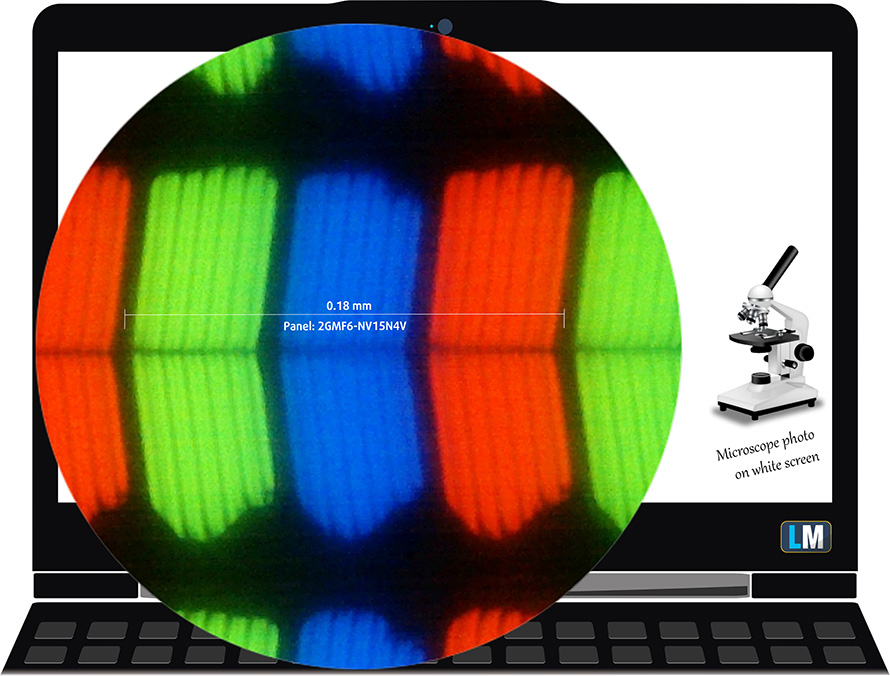
Viewing angles are comfortable. We offer images at 45° to evaluate image quality.

Also, a video with locked focus and exposure.
The measured maximum brightness of 266 nits in the middle of the screen and 252 nits as an average for the whole area, with a maximum deviation of 9%. The Correlated Color Temperature on a white screen is 6830K – slightly colder than the sRGB standard of 6500K, which is great.
In the illustration below you can see how the display performs from a uniformity perspective. In other words, the leakage of light from the light source.
Values of dE2000 over 4.0 should not occur, and this parameter is one of the first you should check if you intend to use the laptop for color-sensitive work. The contrast ratio is good – 1220:1.
To make sure we are on the same page, we would like to give you a little introduction to the sRGB color gamut and the Adobe RGB. To start, there’s the CIE 1976 Uniform Chromaticity Diagram that represents the visible specter of colors by the human eye, giving you a better perception of the color gamut coverage and the color accuracy.
Inside the black triangle, you will see the standard color gamut (sRGB) that is being used by millions of people on HDTV and on the web. As for the Adobe RGB, this is used in professional cameras, monitors, etc for printing. Basically, colors inside the black triangle are used by everyone and this is the essential part of the color quality and color accuracy of a mainstream notebook.
Still, we’ve included other color spaces like the famous DCI-P3 standard used by movie studios, as well as the digital UHD Rec.2020 standard. Rec.2020, however, is still a thing of the future and it’s difficult for today’s displays to cover that well. We’ve also included the so-called Michael Pointer gamut, or Pointer’s gamut, which represents the colors that naturally occur around us every day.
The yellow dotted line shows Dell Latitude 15 5531’s color gamut coverage.
Its display covers 52% of the sRGB/ITU-R BT.709 (web/HDTV standard) in CIE1976.
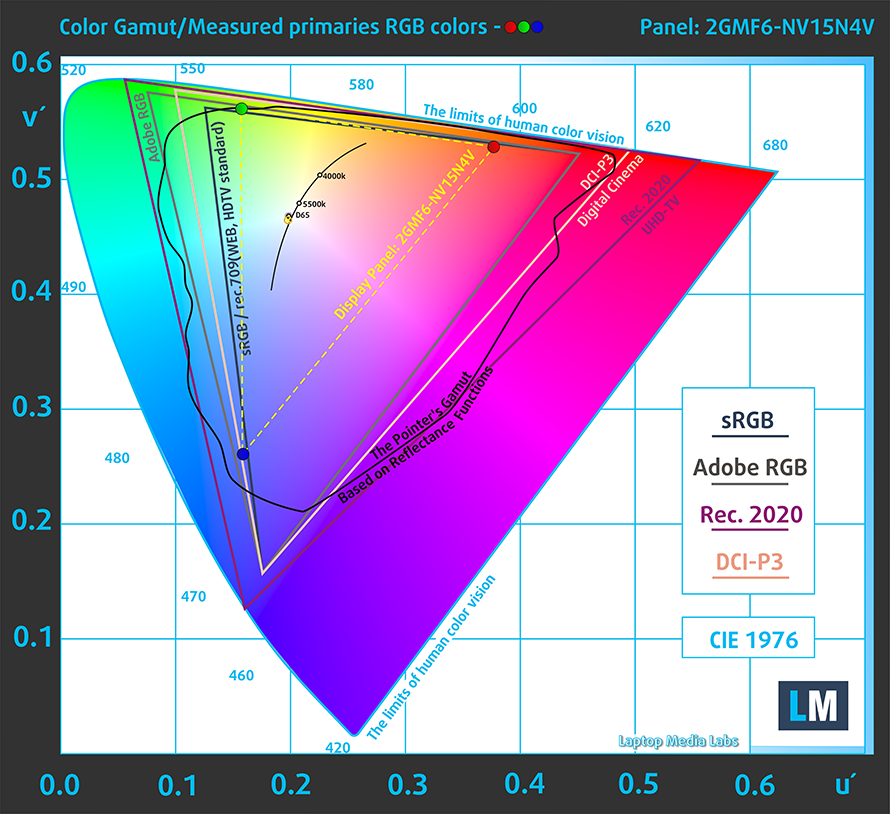
Our “Design and Gaming” profile delivers optimal color temperature (6500K) at 140 cd/m2 luminance and sRGB gamma mode.
We tested the accuracy of the display with 24 commonly used colors like light and dark human skin, blue sky, green grass, orange, etc. You can check out the results at factory condition and also, with the “Design and Gaming” profile.
Below you can compare the scores of Dell Latitude 15 5531 with the default settings (left), and with the “Gaming and Web design” profile (right).
The next figure shows how well the display is able to reproduce really dark parts of an image, which is essential when watching movies or playing games in low ambient light.
The left side of the image represents the display with stock settings, while the right one is with the “Gaming and Web Design” profile activated. On the horizontal axis, you will find the grayscale, and on the vertical axis – the luminance of the display. On the two graphs below you can easily check for yourself how your display handles the darkest nuances but keep in mind that this also depends on the settings of your current display, the calibration, the viewing angle, and the surrounding light conditions.
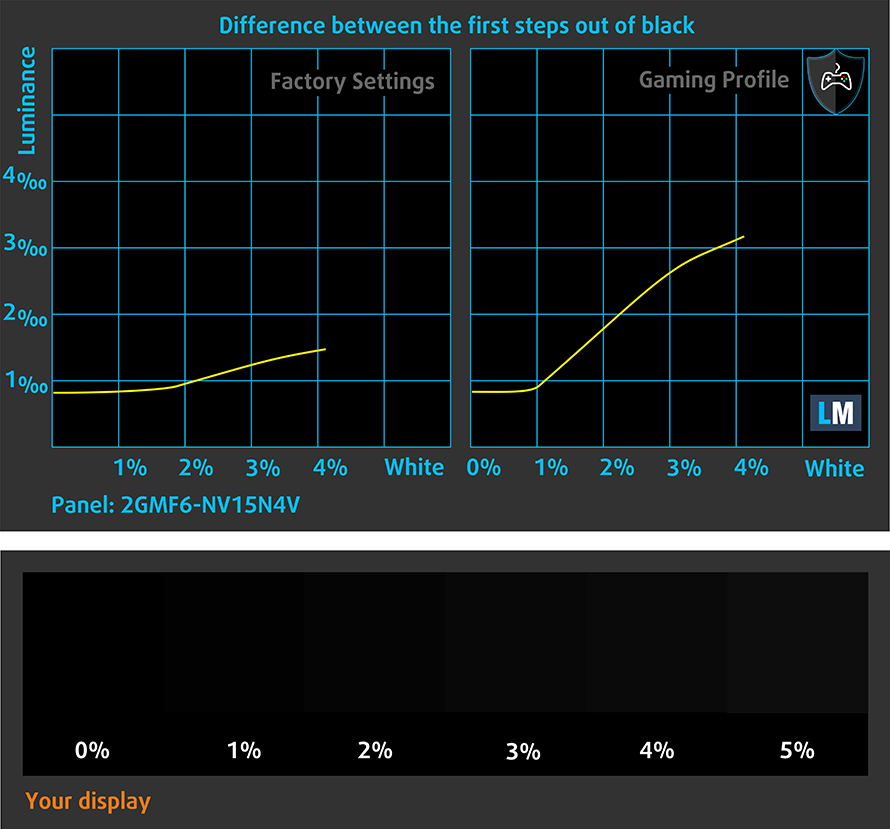
Response time (Gaming capabilities)
We test the reaction time of the pixels with the usual “black-to-white” and “white-to-black” method from 10% to 90% and vice versa.
We recorded Fall Time + Rise Time = 28 ms.
After that, we test the reaction time of the pixels with the usual “Gray-to-Gray” method from 50% White to 80% White and vice versa between 10% and 90% of the amplitude.
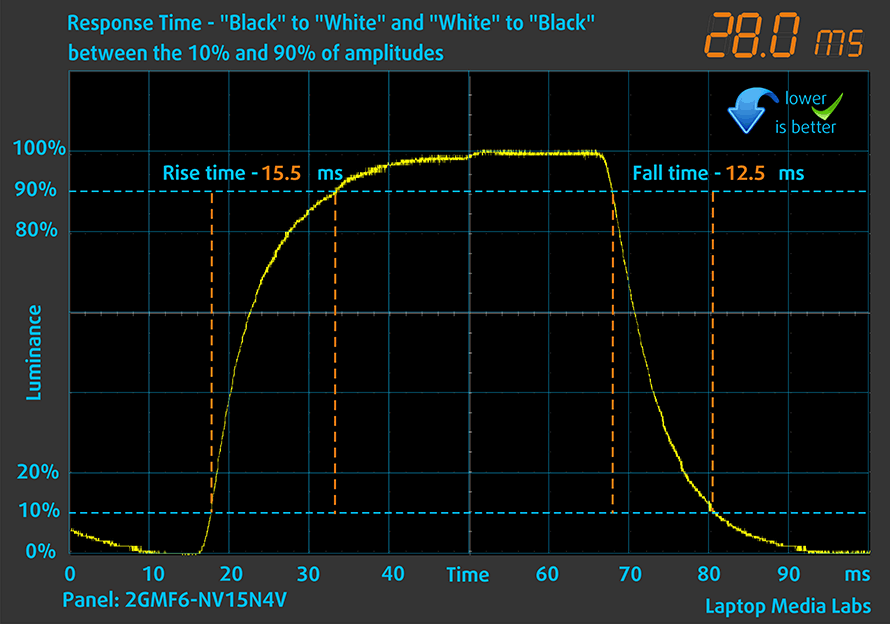
After that, we test the reaction time of the pixels with the usual “Gray-to-Gray” method from 50% White to 80% White and vice versa between 10% and 90% of the amplitude.
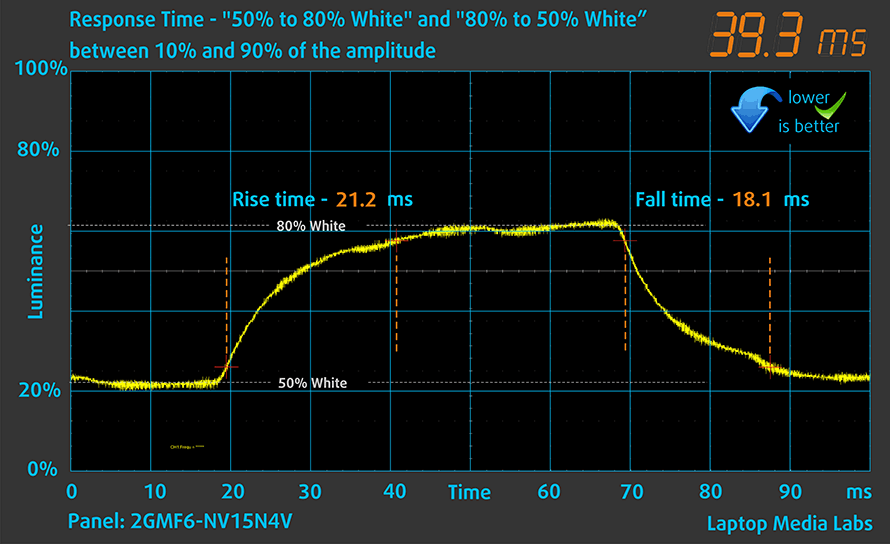
PWM (Screen flickering)
Pulse-width modulation (PWM) is an easy way to control monitor brightness. When you lower the brightness, the light intensity of the backlight is not lowered, but instead turned off and on by the electronics with a frequency indistinguishable to the human eye. In these light impulses, the light/no-light time ratio varies, while brightness remains unchanged, which is harmful to your eyes. You can read more about that in our dedicated article on PWM.
Dell Latitude 15 5531’s display doesn’t use PWM only at maximum brightness. This is not ideal, but our Health-Guard profile fixes the issue entirely.
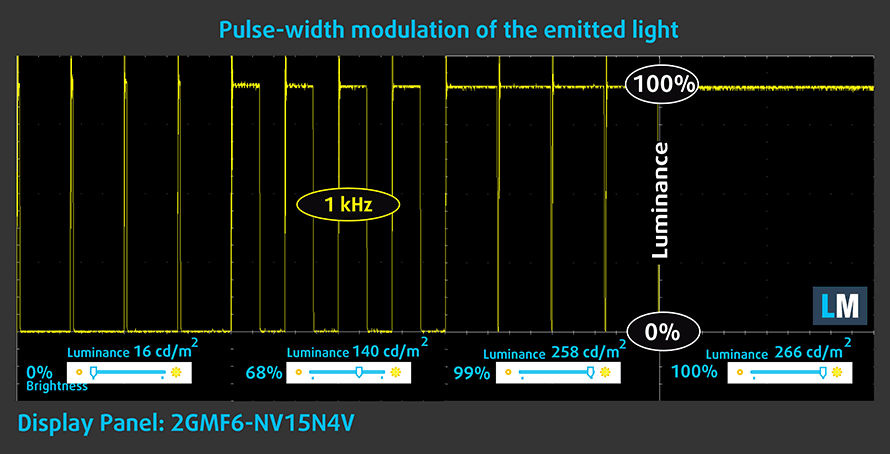
Blue light emissions
Installing our Health-Guard profile not only eliminates PWM but also reduces the harmful Blue Light emissions while keeping the colors of the screen perceptually accurate. If you’re not familiar with the Blue light, the TL;DR version is – emissions that negatively affect your eyes, skin, and your whole body. You can find more information about that in our dedicated article on Blue Light.
Buy our profiles
Since our profiles are tailored for each individual display model, this article and its respective profile package are meant for Dell Latitude 15 5531 configurations with 15.6″ FHD IPS BOE 2GMF6-NV15N4V (BOE0928).
*Should you have problems with downloading the purchased file, try using a different browser to open the link you’ll receive via e-mail. If the download target is a .php file instead of an archive, change the file extension to .zip or contact us at [email protected].
Read more about the profiles HERE.
Naast het ontvangen van efficiënte en gezondheidsvriendelijke profielen, steunt u door het kopen van LaptopMedia's producten ook de ontwikkeling van onze laboratoria, waar wij apparaten testen om de meest objectieve beoordelingen mogelijk te maken.

Office Work
Office Work moet vooral worden gebruikt door gebruikers die de meeste tijd besteden aan het bekijken van stukken tekst, tabellen of gewoon surfen. Dit profiel is gericht op het leveren van een betere helderheid en duidelijkheid door het behouden van een vlakke gammacurve (2.20), native kleurtemperatuur en perceptueel accurate kleuren.

Ontwerp en spel
Dit profiel is gericht op ontwerpers die beroepsmatig met kleuren werken, en ook voor games en films. Design and Gaming brengt beeldschermen tot het uiterste en maakt ze zo nauwkeurig mogelijk in de sRGB IEC61966-2-1 standaard voor Web en HDTV, bij witpunt D65.

Health-Guard
Health-Guard elimineert de schadelijke Pulse-Width Modulation (PWM) en vermindert het negatieve Blauwe Licht dat onze ogen en ons lichaam aantast. Omdat het op maat is gemaakt voor elk paneel, slaagt het erin de kleuren perceptueel nauwkeurig te houden. Health-Guard simuleert papier zodat de druk op de ogen sterk wordt verminderd.
Krijg alle 3 de profielen met 33% korting
Sound
Dell Latitude 15 5531’s speakers produce a sound of good quality. However, there are some deviations across the entire frequency spectrum.
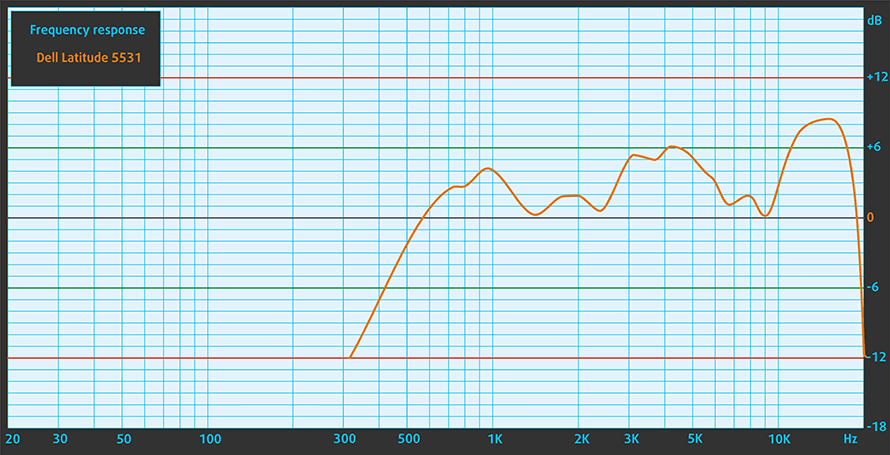
Drivers
All drivers and utilities for this notebook can be found here: https://www.dell.com/support/home/en-us/product-support/product/latitude-15-5531-laptop/drivers
Battery
Now, we conduct the battery tests with the Windows Better performance setting turned on, screen brightness adjusted to 120 nits, and all other programs turned off except for the one we are testing the notebook with. This device’s 64Wh battery lasts for 10 hours and 22 minutes of Web browsing, or 8 hours and 40 minutes of video playback.
Om de werkelijke omstandigheden te simuleren, hebben wij ons eigen script gebruikt voor automatisch surfen op het web langs meer dan 70 websites.
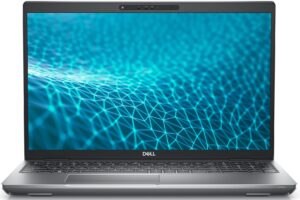
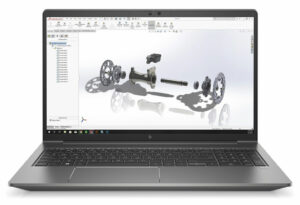
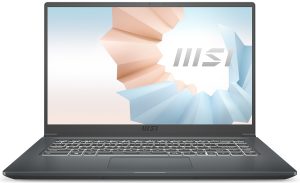
Voor elke test als deze, gebruiken we dezelfde video in HD.



CPU options
Here, you get three processor options – Core i5-12500H, Core i5-12600H, or Core i7-12800H.
De resultaten zijn afkomstig van de Cinebench R23 CPU-test (hoe hoger de score, hoe beter)
Resultaten zijn van onze Photoshop benchmark test (hoe lager de score, hoe beter)
GPU options
Interestingly, the 45W CPUs are paired with an optional GeForce MX550 with 2GB GDDR6 VRAM.
De resultaten zijn afkomstig van de 3DMark: Time Spy (Graphics) benchmark (hoe hoger de score, hoe beter)
Resultaten zijn van de 3DMark: Fire Strike (Graphics) benchmark (hoe hoger de score, hoe beter)
De resultaten zijn afkomstig van de 3DMark: Wild Life benchmark (hoe hoger de score, hoe beter)
Resultaten zijn van de Unigine Superposition benchmark (hoe hoger de score, hoe beter)
Gaming tests

| CS:GO | HD 1080p, Low (Check settings) | HD 1080p, Medium (Check settings) | HD 1080p, MAX (Check settings) |
|---|---|---|---|
| Average FPS | 335 fps | 241 fps | 144 fps |

| DOTA 2 | HD 1080p, Low (Check settings) | HD 1080p, Normal (Check settings) | HD 1080p, High (Check settings) |
|---|---|---|---|
| Average FPS | 229 fps | 151 fps | 126 fps |
Temperatures and comfort
Max CPU load
In this test we use 100% on the CPU cores, monitoring their frequencies and chip temperature. The first column shows a computer’s reaction to a short load (2-10 seconds), the second column simulates a serious task (between 15 and 30 seconds), and the third column is a good indicator of how good the laptop is for long loads such as video rendering.
Average P-core frequency; Average E-core frequency; CPU temp.; Package Power
| Intel Core i5-12600H (45W TDP) | 0:02 – 0:10 sec | 0:15 – 0:30 sec | 10:00 – 15:00 min |
|---|---|---|---|
| Dell Latitude 15 5531 | 3.60 GHz @ 2.67 GHz @ 70°C @ 80W | 3.61 GHz @ 2.67 GHz @ 79°C @ 80W | 2.68 GHz @ 2.23 GHz @ 72°C @ 45W |
Obviously, a single fan wouldn’t have the same cooling capacity as the systems on gaming machines. However, it is still doing a decent job when it comes to maintaining the 45W base TDP. Also, the average core temperature is pretty low too.
Real-life gaming
| NVIDIA GeForce MX550 | GPU frequency/ Core temp (after 2 min) | GPU frequency/ Core temp (after 30 min) | GPU frequency/ Core temp (Max fan) |
|---|---|---|---|
| Dell Latitude 15 5531 | 1517 MHz @ 74°C @ 35W | 1529 MHz @ 75°C @ 35W | – |
In this case, we are not 100% positive about the TGP maximum of the MX550. However, 35W seems good enough for an energy-efficient GPU, and the temperature of 75°C at the end of the test looks fine enough as well.
Comfort during combined load
On the other hand, the laptop gets pretty warm on the outside. The top-center part of the keyboard is plain hot to the touch, but on the bright side, you will rarely go near this location in normal use.
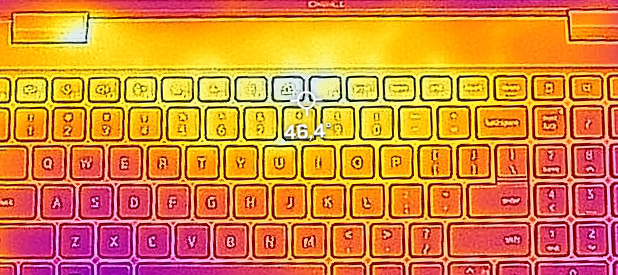
Verdict
 If you’ve seen our Latitude 15 5530 review, then, you should know that the downsides of owning a 5531 are pretty much the same – no keyboard spill resistance, and narrow color coverage. On the other hand, you do get optional 5G support, as well as an IR, face recognition scanner, a fingerprint reader, and Wi-Fi 6E support.
If you’ve seen our Latitude 15 5530 review, then, you should know that the downsides of owning a 5531 are pretty much the same – no keyboard spill resistance, and narrow color coverage. On the other hand, you do get optional 5G support, as well as an IR, face recognition scanner, a fingerprint reader, and Wi-Fi 6E support.
Dell Latitude 15 5531’s IPS panel has a Full HD resolution, comfortable viewing angles, and a good contrast ratio. You know – all of the goodies of the IPS technology. Unfortunately the backlight doesn’t use PWM for brightness adjustment, while the screen only covers 52% of the sRGB color gamut, which results in a pretty dull-looking image.
Interestingly, despite the use of a 45W CPU, and even with the smaller 64Wh battery pack, the laptop manages to last for more than 10 hours of Web browsing, or nearly 9 hours of video playback. This means it should last you through an entire workday. However, if your workflow includes intensive apps like Solidworks, CAD software, and all alike, you shouldn’t be unplugging the charger in the first place.
By the way, this is the exact reason why one would want to buy the Latitude 15 5531 instead of the 5530 – more power. Even the Core i5-12600H has the performance to take on the top dogs of last year. And the fact that you get vPro capability, as well as two slots of DDR5 memory means you can take advantage of the higher bandwidth of the new generation memory.
Speaking of the new generation, there are two M.2 PCIe x4 SSD slots, but we found no information about the support of Gen 4 drives. On the bright side, we can tell you that it does support RAID 0 and RAID 1.
Also, we wanted to test the MX550 which turned out to be more than capable for casual gaming. You can play Battlefield V, Shadow of the Tomb Raider, or GTA V on High settings, without any issues.
With two Thunderbolt 4 connectors, a MicroSD card slot, two regular USBs, and more, you get an extensive enough I/O. And if you do need more ports, you can also attach a docking station – something Dell appears to have fully mastered thanks to their experience in the business.
You can check the prices and configurations in our Specs System: https://laptopmedia.com/series/dell-latitude-15-5531/
Pros
- Wide I/O, which includes a MicroSD card reader and 2x Thunderbolt 4 ports
- Two M.2 storage slots with RAID support + 2x DDR5 RAM SODIMM slots
- Fingerprint reader embedded in the power button + optional IR face recognition
- Comfortable keyboard with a backlight
- Good battery life
- Wi-Fi 6E + 5G support (optional)
- GeForce MX550 option + fantastic computational performance
Cons
- Covers only 52% of sRGB (BOE 2GMF6-NV15N4V (BOE0928))
- No spill-resistance
- Uses PWM (our Health-Guard profile fixes the issue) (BOE 2GMF6-NV15N4V (BOE0928))



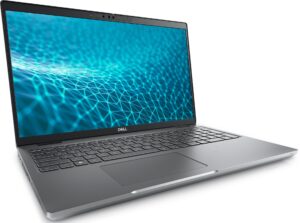
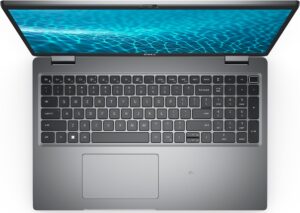
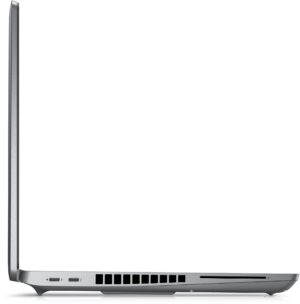
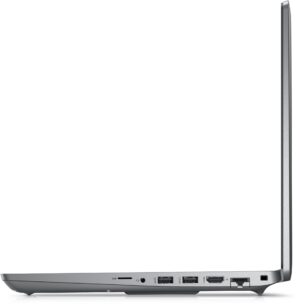
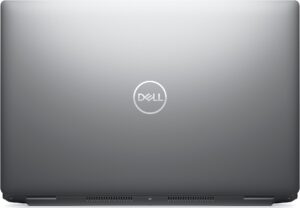
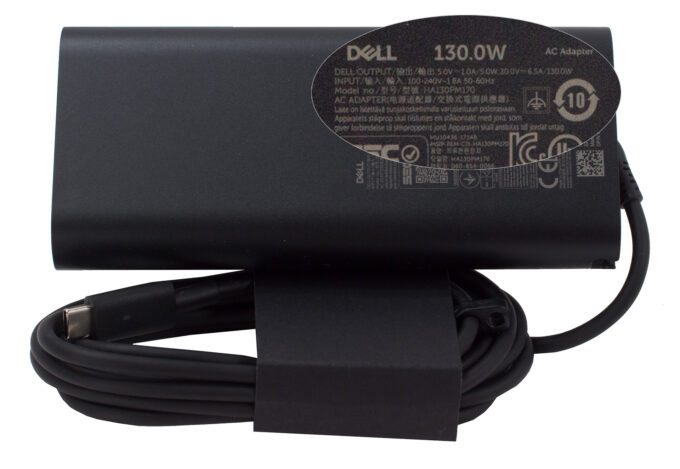

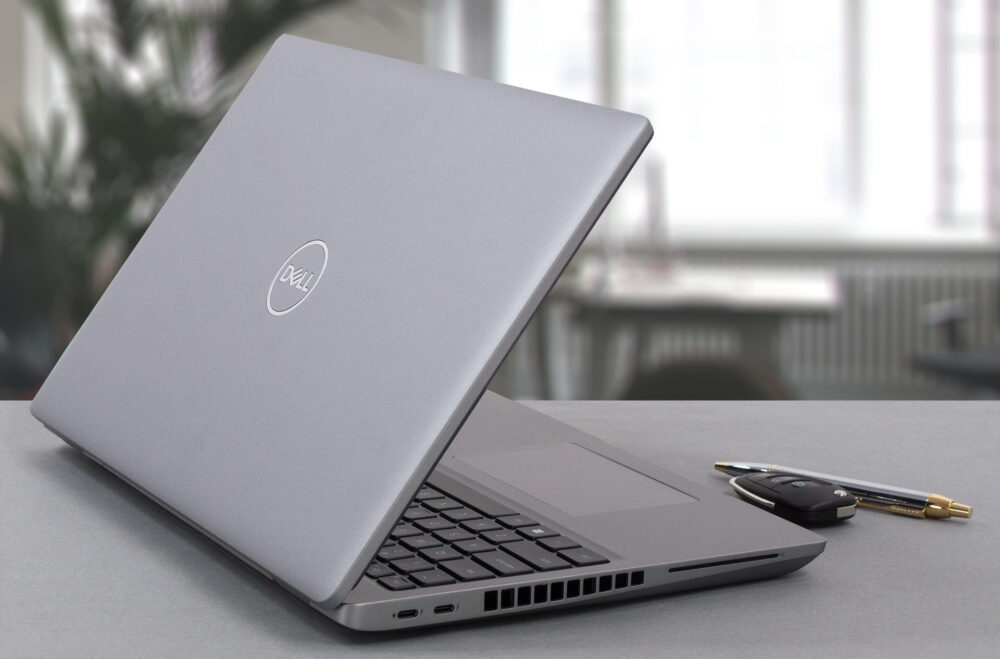

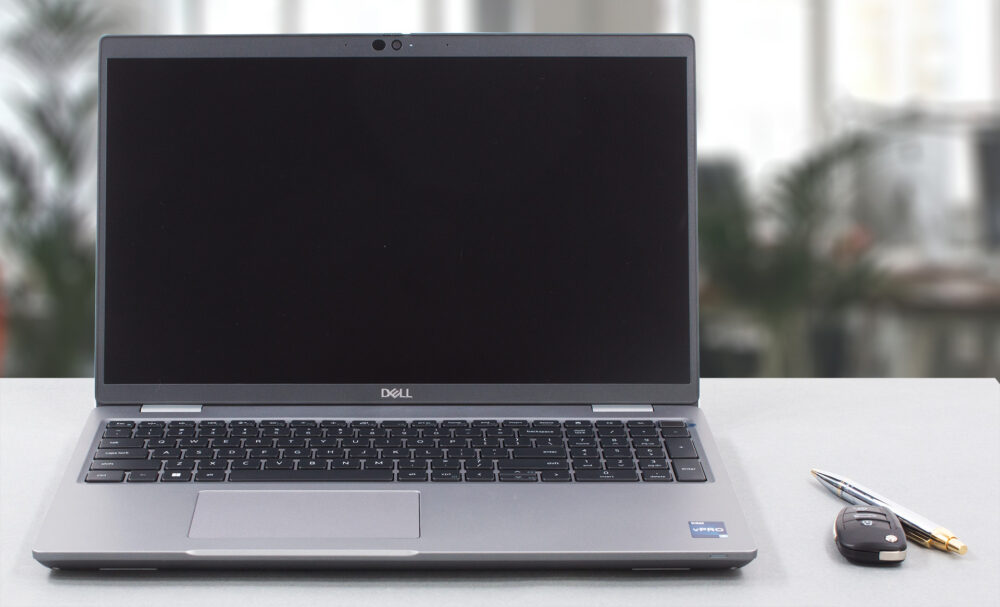
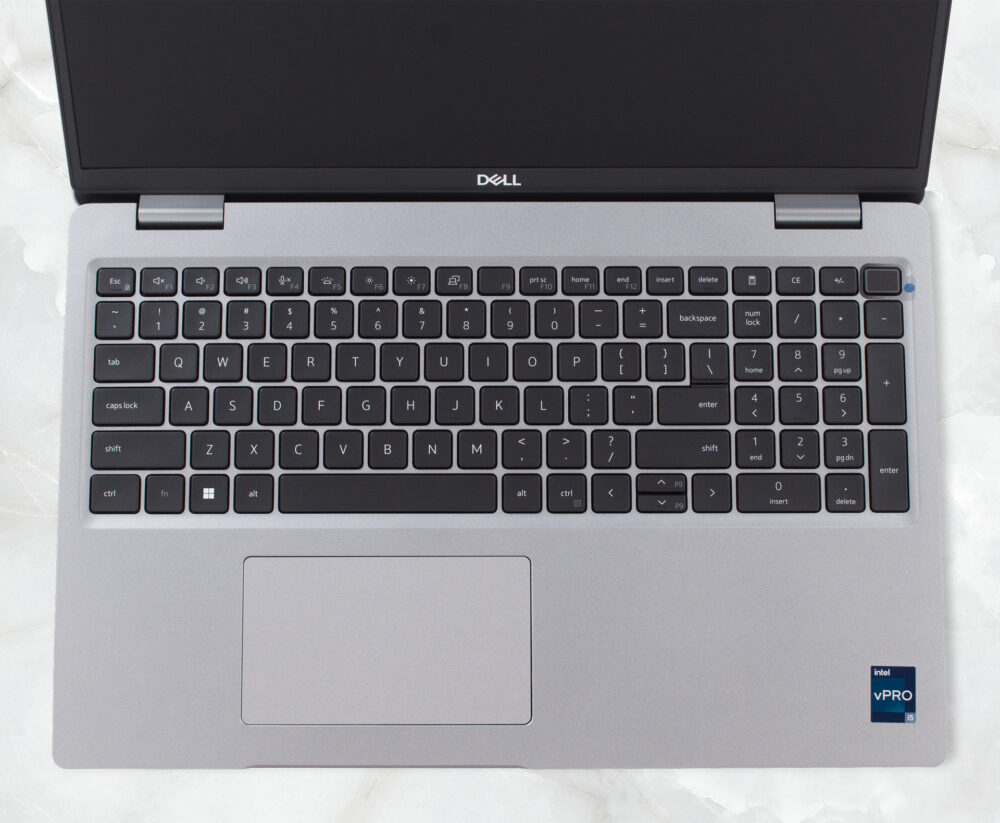
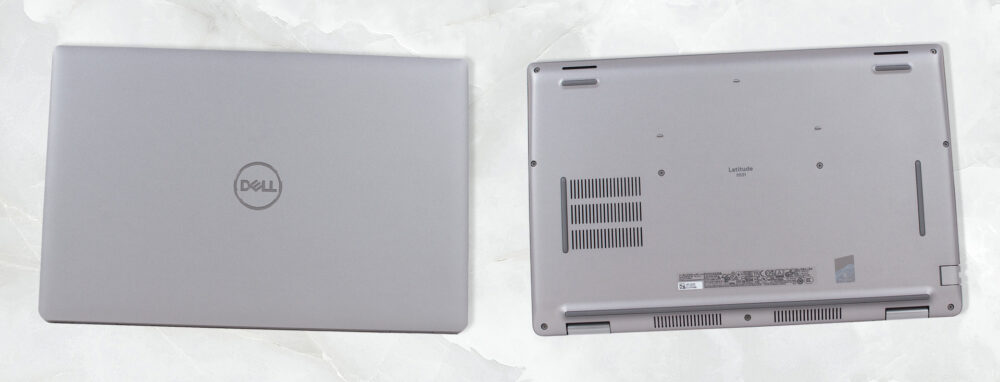




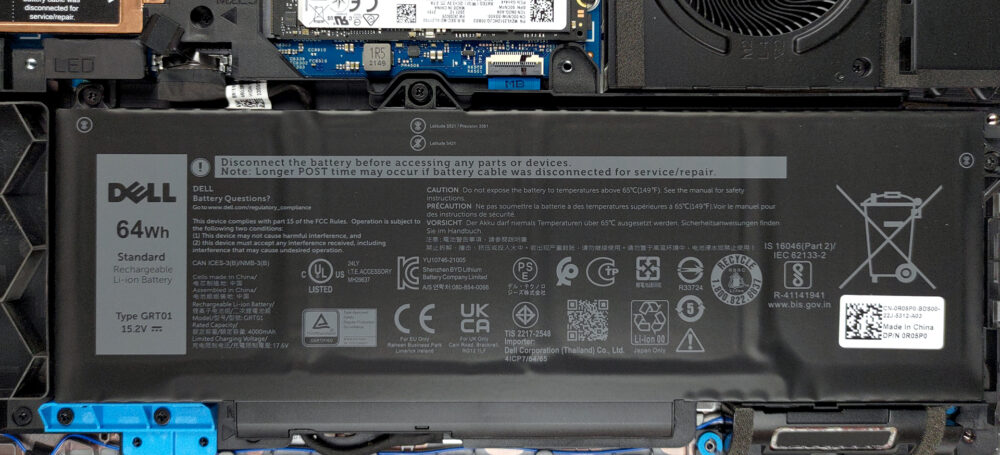

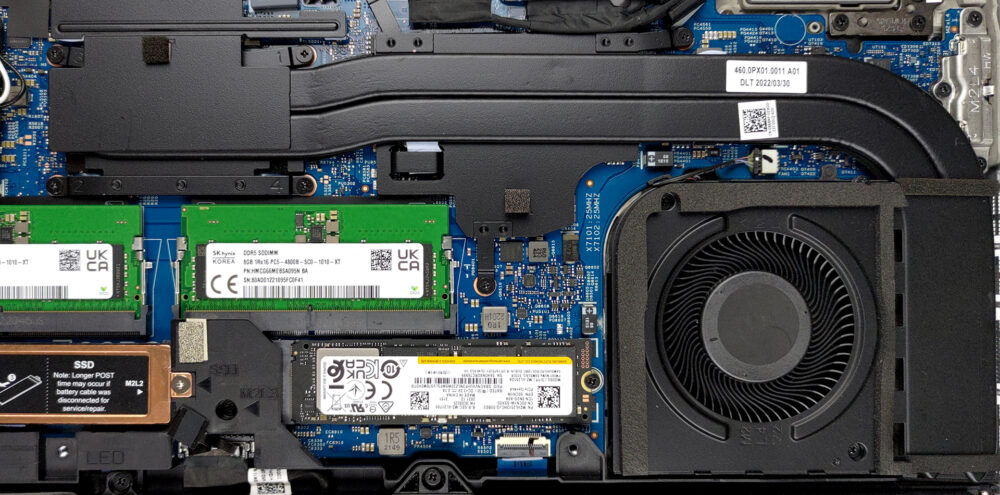
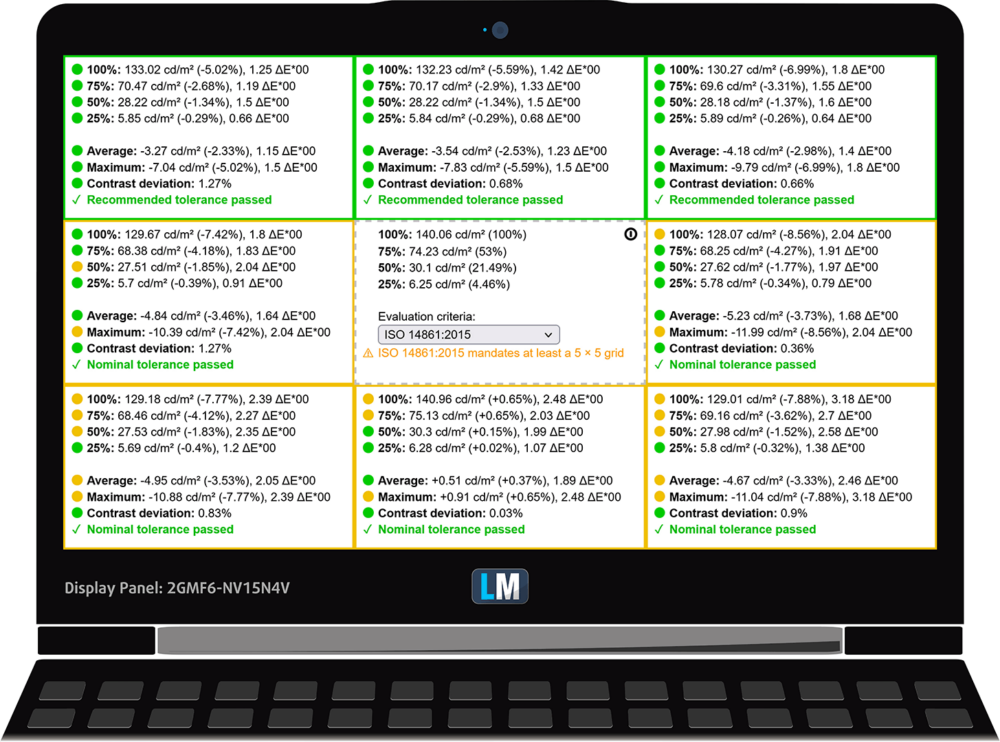
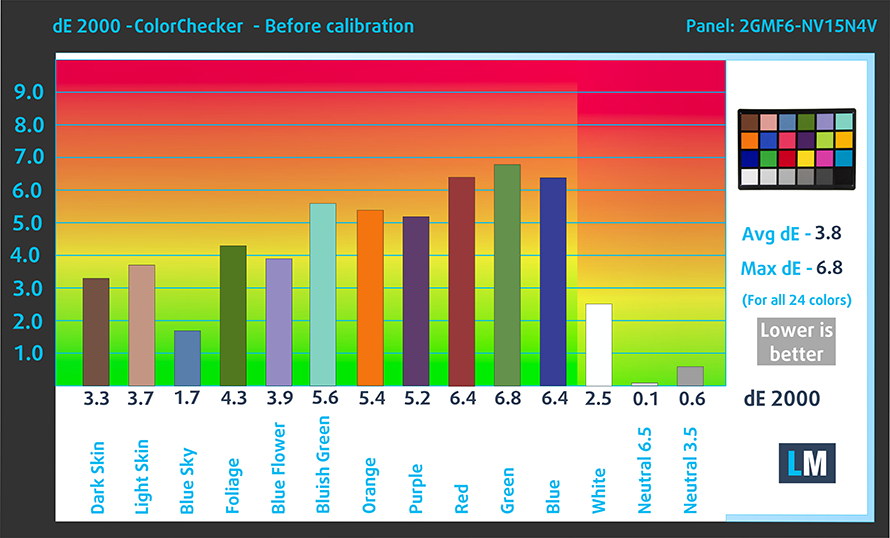
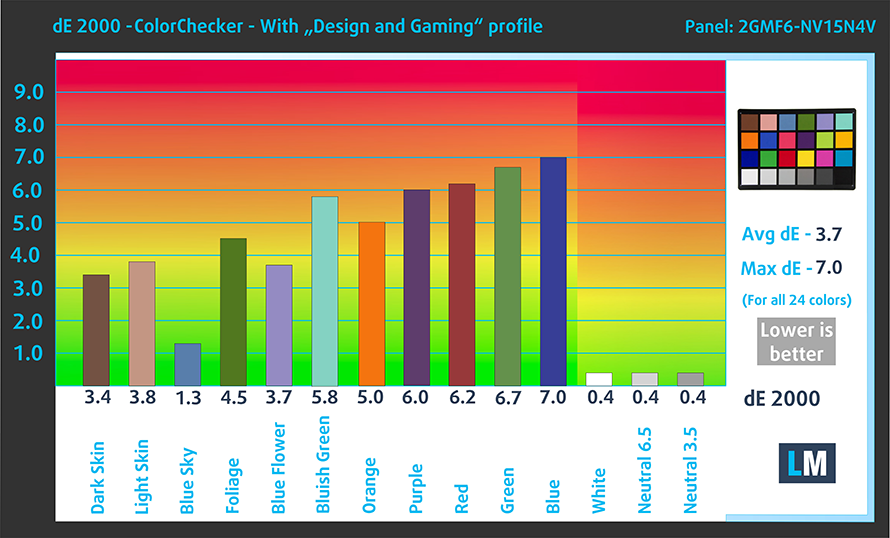

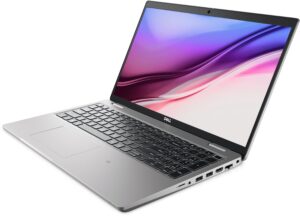
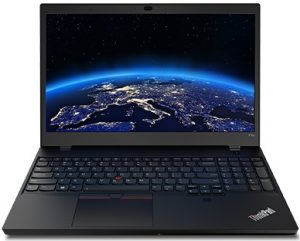
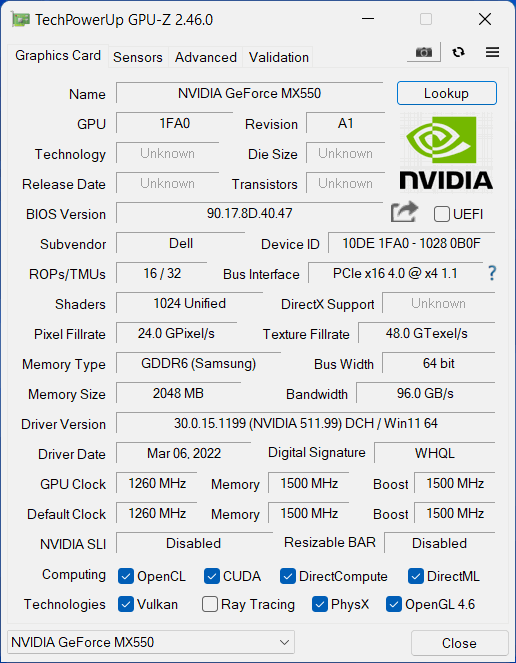







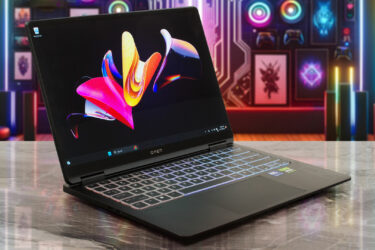
From what I can make out in the manual, only one of the two SSD slots supports PCIe 4.0 – the one on the left with the heat shield.
Worst and most expensive laptop I ever had